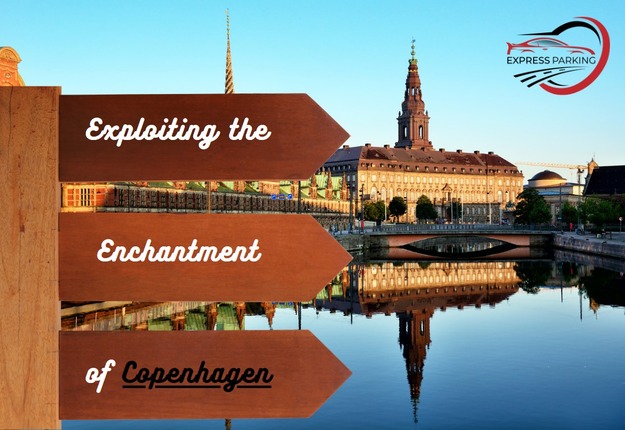In a world that boasts a multitude of captivating destinations, Copenhagen, Denmark’s capital, stands out as a city that effortlessly combines the old with the new, the traditional with the modern, and the historical with the cutting-edge.
Located on the eastern coast of the picturesque island of Zealand, Copenhagen is a place where fairy tales come to life and where history, culture, and innovation converge in perfect harmony.
With its enchanting canals, world-renowned gastronomy, and a strong commitment to sustainability, Copenhagen is more than just a destination; it’s an experience like no other.
| Cheapest Heathrow airport parking offers the ultimate convenience for travellers. Our parking facilities are situated just moments away from the airport terminals so you don’t have to deal with lengthy transfers or shuttle buses. |
Short History of Copenhagen
Copenhagen, the vibrant and historic capital of Denmark, has a story that spans centuries, shaping it into the enchanting city we know today.
Copenhagen’s history can be traced back to the Viking Age when it was originally a small fishing village. Located at the crossroads of important trade routes, the village soon grew into a bustling market town.
While Copenhagen and Athens stand as distinct cultural and historical bastions, tracing the lineage of Copenhagen reveals a narrative intertwined with the ebbs and flows of time, echoing the resilient spirit shared with ancient Athens, albeit in a Nordic context.”
In the 15th century, Copenhagen became home to the Danish monarchy. During the 17th century, Copenhagen experienced significant Dutch influence in its urban planning and architecture.
This period saw the development of its unique canals and the construction of iconic buildings.
Copenhagen played a crucial role in the Napoleonic Wars. In 1807, the British Royal Navy famously bombarded the city to secure the Danish fleet, leading to the loss of numerous historical buildings.
The 19th century marked a period of modernization, with the city’s infrastructure improving and the industrial revolution influencing its development.
In recent decades, Copenhagen has evolved into a global metropolis known for its environmental sustainability, world-class cuisine, and cutting-edge design.
Haven for Cyclists
Copenhagen’s reputation as a haven for cyclists is well-deserved and is one of the standout features that make the city worth visiting.
The city’s dedication to cycling as a primary mode of transportation has resulted in a remarkable, cyclist-friendly urban environment.
Copenhagen boasts an extensive network of dedicated bike lanes, bike paths, and cycling routes throughout the city.
These lanes are well-maintained, clearly marked, and separated from vehicular traffic, providing a safe and convenient cycling experience.
The city’s urban planning prioritises cyclists, with bike lanes often given equal or greater importance than car lanes.
Cyclists have right-of-way at many intersections, and traffic signals are often designed to cater to cyclists, allowing them to move efficiently through the city.
| Planning your trip is already stressful enough; we aim to make airport parking the least of your worries. With the Heathrow Airport valet parking services , you can easily book your parking spot online in advance. |
Sustainability and Green Spaces
Copenhagen’s commitment to sustainability and its abundance of green spaces are two interconnected aspects that greatly contribute to the city’s appeal.
Copenhagen has set an ambitious goal to become the world’s first carbon-neutral capital by 2025. This is a part of the city’s broader strategy to combat climate change and reduce its carbon emissions.
The city government, local businesses, and residents are actively engaged in initiatives to achieve this goal, including transitioning to renewable energy sources, improving energy efficiency, and promoting sustainable transportation.
Copenhagen is blessed with an abundance of parks and green spaces, making it a city that values nature and offers respite from urban life.
Some of the most prominent green areas in the city include King’s Garden, a historical park adjacent to Rosenborg Castle, and Fælledparken, one of the largest public parks in the city. These spaces provide ample room for picnics, sports, and relaxation.
The city planning also incorporates green areas and natural elements into the urban landscape.
Parks and gardens are interspersed throughout the city, offering a harmonious balance between modern infrastructure and natural beauty. This commitment to green spaces contributes to the city’s overall liveability.
Vibrant Culture
Copenhagen’s cultural scene is a dynamic and diverse tapestry that enriches the city’s atmosphere and provides endless opportunities for residents and visitors to engage with the arts, music, design, and more.
It boasts a wide range of museums and galleries that cater to various interests. The National Gallery of Denmark is the largest art museum in Denmark and houses a rich collection of both Danish and international art.
The Louisiana Museum of Modern Art, located just outside the city, is renowned for its contemporary art exhibitions and stunning coastal setting.
Copenhagen has a thriving street art scene, and you’ll find colourful murals, graffiti, and urban installations throughout the city.
The neighbourhood of Nørrebro, in particular, is known for its vibrant street art. The city embraces urban culture, and local artists are encouraged to use public spaces as their canvas.
